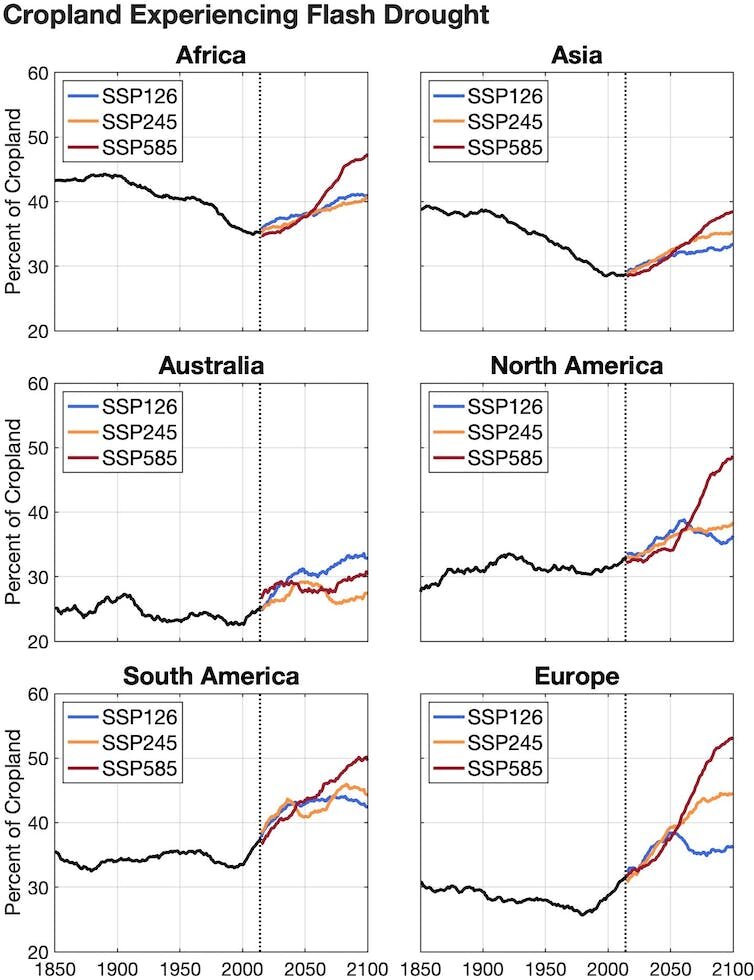Flash droughts have devastating effects on agriculture and are becoming increasingly common as the planet warms. These droughts develop quickly and can cause irreparable damage to a region’s agriculture. In a new study published in Communications Earth & Environment on May 25, 2023, it has been found that the risk of flash droughts is expected to rise in every major agriculture region worldwide in the coming decades. The study used climate models and data from the past 170 years to gauge the drought risks ahead under three scenarios for how quickly the world takes action to slow global warming.
Flash droughts occur when precipitation stops, and during hot and dry weather, soil loses moisture rapidly. Dry air extracts moisture from the land, and rising temperatures can increase this “evaporative demand.” Under these conditions, crops and vegetation begin to die much more quickly than they do during typical long-term droughts. A flash drought can develop in the span of a few weeks and can reinforce itself with some help from the warming climate.
In North America and Europe, cropland that had a 32% annual chance of a flash drought a few years ago could have as much as a 53% annual chance of a flash drought by the final decades of this century. The result would put food production, energy and water supplies under increasing pressure. The cost of damage will also rise. A flash drought in the Dakotas and Montana in 2017 caused US$2.6 billion in agricultural damage in the U.S. alone.
If greenhouse gas emissions from vehicles, power plants and other human sources continue at a high rate, cropland in much of North America and Europe would have a 49% and 53% annual chance of flash droughts, respectively, by the final decades of this century. Globally, the largest projected increases would be in Europe and the Amazon. Slowing emissions can reduce the risk significantly, but flash droughts would still increase by about 6% worldwide under a low-emissions scenario.
The Impact on Agriculture
Flash droughts can have a devastating impact on agriculture as they can destroy an entire crop if it occurs at a critical point in the growing season. For example, corn is most vulnerable during its flowering phase, called silking, which typically happens in the heat of summer. If a flash drought occurs during this time, it can have extreme consequences. However, a flash drought closer to harvest can actually help farmers, as they can get their equipment into the fields more easily.
In the southern Great Plains, winter wheat is at its highest risk during seeding, which happens in September to October the year before the crop’s spring harvest. When flash droughts occur during that fall seeding period, the following year’s yields can be greatly reduced. Looking globally, paddy rice, a staple for more than half the global population, is at risk in northeast China and other parts of Asia. Other crops are at risk in Europe.
Ranches can also be hit hard by flash droughts. During the huge flash drought in 2012 in the central U.S., cattle ran out of forage and water became scarcer. If rain doesn’t fall during the growing season for natural grasses, cattle don’t have food, and ranchers may have little choice but to sell off part of their herds.
The Impact on Energy and Water Supplies
It’s not just agriculture that is affected by flash droughts. Energy and water supplies can also be at risk. In Europe’s intense summer drought in 2022, water levels fell so low in some rivers that power plants shut down because they couldn’t get water for cooling, compounding the region’s problems. Events like these are a window into what countries are already facing and could see more of in the future.
Managing the Risk
One way to help agriculture adapt to the rising risk is to improve forecasts for rainfall and temperature, which can help farmers as they make crucial decisions, such as whether they’ll plant or not. However, flash droughts evolve in a midrange window of time that is difficult to forecast. Scientists are tackling the challenge of monitoring and improving the lead time and accuracy of forecasts for flash droughts. Monitoring tools like the United States Drought Monitor’s experimental short-term map that can display developing flash droughts are being developed. As scientists learn more about the conditions that cause flash droughts and their frequency and intensity, forecasts and monitoring tools will improve.
Increasing awareness can also help. If short-term forecasts show that an area is not likely to get its usual precipitation, that should immediately set off alarm bells. If forecasters are also seeing the potential for increased temperatures, that heightens the risk for a flash drought’s developing.
Nothing is getting easier for farmers and ranchers as global temperatures rise. Understanding the risk from flash droughts will help them, and anyone concerned with water resources, manage yet another challenge of the future.



Leave a Reply